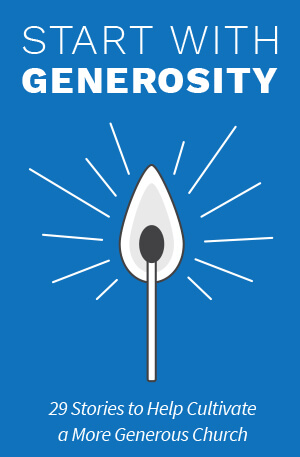The Role of Online Giving During A Crisis
In the face of adversity, we often find our greatest strengths and most profound moments of growth. It is during these challenging times that the resilience and adaptability of communities are put to the test.
As churches navigate through crises, the role of technology becomes increasingly apparent. Online church isn’t just a temporary solution—it’s a powerful tool that fosters connection, compassion, and generosity when they need it most. Online giving, in particular, has proven to be a lifeline for churches, enabling them to continue their mission and support their communities in times of need.
The Impact of Online Giving in Crisis
In times of crisis, the importance of community and generosity becomes increasingly evident. As you navigate challenging times, it’s heartening to witness how churches have weathered financial crises with the help of online giving.
Few stories illustrate this better than that of St. Anthony of Padua. They managed to increase their generosity even amidst the pandemic. They launched their campaign in January 2020, just before the pandemic. Their goal was to raise $6.5 million, but with online giving, pledges, and determination, they surpassed their goal and raised $7.5 million. In a time when many were facing financial difficulties and weren’t able to meet and give in person, the church experienced an upswing in donations, thanks in part to their adoption of online giving.
The Grove Church and Bear Creek Church also have stories of making an impact with online giving. Despite the adversities thrown their way, from a pandemic to an economic recession, they managed to maintain and even increase their financial stability through online giving platforms. These stories underline a powerful truth: Online giving is more than just a convenience; it’s a lifeline in times of crisis.
The Power of Recurring Giving in Building Resilience
Recurring giving isn’t just a financial strategy. It’s a cornerstone of a resilient ministry. It offers a predictable revenue stream and increased donor retention so churches can plan effectively and continue fulfilling their mission in any season.
The beauty of recurring giving (for everyone involved) lies in its simplicity.
With consistent donations flowing in month after month, your church can confidently anticipate your revenue stream and plan accordingly. This improved cash flow establishes a strong foundation for better long-term planning and budgeting, empowering your ministry’s operations and initiatives.
But the impact of recurring giving extends beyond your ministry—it also benefits the donors themselves.
Donors set up their contributions once, choosing the amount and frequency that suits them best. This convenience often leads to long-term commitments, as it removes the need for donors to remember to give each week or month. And according to Nonprofit Source, recurring givers donate 42% more over a year compared to one-time donors. These consistent contributions can have a significant impact, equipping your ministry for survival and resilience even during times of crisis.
Start with
Generosity
Learn how to cultivate a culture of generosity in your church.

Consistent gifts provide churches with the ability to plan ahead and strategically allocate resources to critical areas, ranging from vital ministry work to impactful community outreach programs. However, the true value of these recurring contributions shines through during times of crisis.
With consistent, established recurring giving, your church can do more than just meet the needs around you; you’ll have the resources to go above and beyond in your mission to serve, love, and uplift your community. By building a strong foundation of support, your church can navigate challenges with resilience. You’ll be able to not only survive but thrive and emerge stronger than ever before.
How to Create Online Giving Campaigns During a Crisis
Sometimes crises call for more resources—that’s when a campaign can help. Initiating an effective giving campaign requires strategic planning, clear communication, and a deep understanding of your community’s needs. And all of those can be hard to wrangle and bring together during a crisis.
Pushpay’s online giving solution can help you quickly set up a crisis fund, so people near and far can be generous and provide much-needed aid. Watch the short video below for tips on generating easy-to-share links or QR Codes for your church.
Now that you know how to create a campaign, it’s time to figure out the what. Here are some strategies to support your communities during a crisis.
Shine a Light on Mental Health
Crises can often trigger a surge in mental health struggles. Your church can underscore the importance of mental health with campaigns aimed at educating or even providing resources to your congregation and the wider community.
In response to the hopelessness and desperation that so many people felt during the COVID-19 pandemic, Christ’s Church of the Valley launched its Press On initiative. For over 4,000 people who texted “help” during their campaign, Christ’s Church of the Valley shared resources and helped pay for their first ten counseling sessions.
Connect Campaigns with Community Services
Consider pairing your giving campaign with supportive services. A campaign focused on community service not only meets pressing needs but also fosters a sense of unity and resilience. This could involve organizing food drives, assisting the elderly or vulnerable, or mobilizing volunteers for local clean-up projects. Coupling your campaigns with these acts of service creates a more comprehensive crisis relief within your community, tackling immediate needs and paving the way for long-term recovery.
Create a Standing “Emergency Fund” Campaign
Even if you’re not facing a crisis right now, there are steps you can take to be ready whenever one hits. By setting up an ongoing emergency fund, your church can be (more) prepared to face any crisis head-on. Regular contributions to this fund mean there are always resources at hand whenever adversity strikes.
Monitoring Giving Trends in a Crisis
In a crisis, the landscape of charitable giving often shifts. Some people will feel a pull in their hearts to give more generously, while others suddenly need a helping hand.
Understanding your church’s giving trends—donor behavior, donation frequency and amount, peak giving days, and even donor retention rates—becomes crucial in a crisis. Because data drives decisions. It’s not just about keeping the lights on; it’s about adapting, supporting people in need, and ensuring that your church can continue its mission no matter what comes your way.
Recognizing patterns in your giving data will help you tailor your fundraising campaigns for maximum impact and identify potential challenges early on. If donations are declining, you can take proactive steps to address this issue, whether that’s through communication, engagement, or other strategies.
Start with
Generosity
Learn how to cultivate a culture of generosity in your church.

With Pushpay’s financial dashboard, administrators can easily generate reports based on real-time giving data. The insights can range from the number of donations or givers to the payment methods used. And armed with those insights, your team will be able to understand what’s currently happening and what could happen next. This information is invaluable, helping your church adapt its strategies to continue supporting those in need and fulfill its mission.
But recognizing trends data is just one part of the process. To create effective fundraising campaigns in a crisis, you also need to focus on the people behind the numbers—your donors. At the heart of every donation is a person wanting to make a difference. Our donor management software makes it easier for churches to connect with and appreciate donors with personalized messages and timely communications. Speaking of…
Appreciating Your Donors During and After a Crisis
Every donation takes on added significance when you’re in a crisis. Each one is a lifeline, providing much-needed support to those impacted by the crisis. It’s in these moments that the act of giving becomes more than a transaction—it becomes a testament to the resilience and compassion of our community.
In this context, appreciating your donors goes beyond saying “thank you.” It’s about recognizing the weight of their contribution during such challenging times, acknowledging the sacrifice they might have made to extend their generosity amidst the crisis.
But how can we show this appreciation most effectively?
It starts with a personalized thank-you note immediately after they give. With Pushpay Giving, you can create unique thank-you messages for each fund, including campaigns. These unique messages can underscore the significance of that specific donation and how that donor has helped to make a difference. It’s a simple gesture that can strengthen community bonds significantly, especially in times of crisis. But don’t let the conversation end there.
Regularly update your donors on how their contributions are making a difference. Are their donations helping to feed families in need? Are they contributing to the construction of much-needed infrastructure? Let them know! This transparency builds trust in your relationship with your donor and reinforces the value of their contribution.
Even after the crisis has passed, it’s crucial to maintain these connections. Continue to acknowledge their supportive role during the crisis, remind them of the impact of their generosity, and inspire them to stay involved.
Moving Forward Together
A crisis can be challenging, but it also opens up opportunities for compassion, generosity, and resilience. By leveraging online giving, understanding your donor behavior, and appreciating every contribution, you can navigate these challenging times and move forward stronger than before. Because it’s not just about raising funds—it’s about raising hope.
We’re here to support you through the highs, the lows, and the moments in between. For additional resources that can help you prepare and lead in crises, visit our Crisis Resource Page.
Featured Content
You May Also Like
